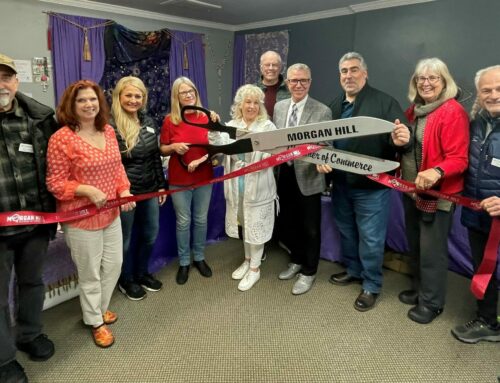Published in the July 20 – Aug. 2, 2016 issue of Morgan Hill Life

China and Gilroy Gardens meet at Luminations celebration with theme park garlic mascot posing with visitor next to Lions Gate.
Photo by Marty Cheek
With the recent opening of the Lumination special attraction at Gilroy Gardens Family Theme Park, the South Valley region is building a stronger relationship with China as a business center in California. The Chinese lantern festival, which runs until the end of November, is a spectacular display of hand-crafted works of art lit by LED bulbs inside, turning the park after sunset into a dreamlike wonderland. Fifty workers from Zigong resided in the park to create the experience that is expected to attract hundreds of thousands of visitors.
The Chinese Consulate in San Francisco visited the theme park while the lanterns were being built and installed. It hopes to help promote Lumination as a bridge-building experience for Bay Area residents to discover and appreciate Chinese culture and art. California and China have long had a relationship with each other, starting in the 1850s when many Chinese came here to flee war and starvation and find riches in what they called “The Golden Mountain.” In 1848 at the start of the Gold Rush, there were only 325 Chinese in California. By 1880, there were more than 300,000, a tenth of the state’s population.
With a strong work ethic, the Chinese were indispensable in building the Golden State into one of the economic powers of the world. Many of them came to work on the First Transcontinental Railroad, laboring in intense and dangerous conditions in the Sierras to cut the path across the continent and link California to the population centers and markets of the East Coast. They also built an agricultural industry, working in the fields of the Central Valley. By 1870, about 75 percent of the farm work in California was done by a Chinese work force. And many of these immigrants became business owners themselves in retail, restaurant, laundry and fishing industries.
As the population grew, many of the Chinese gathered in “Chinatown” districts in San Francisco, San Jose and Los Angeles. What is now downtown Gilroy once had a Chinatown settlement for laborers in the local fields and orchards when hundreds of Chinese men, women and children came to the region in the 1860s. Many worked at the Consolidated Tobacco Company of Gilroy, started by a New York tobacco grower named James D. Culp. In 1873, Culp patented a curing process, built the world’s largest cigar company on Monterey Street near the railroad yard, and hired 900 Chinese workers in his Gilroy plant to roll one million cigars a month. By 1875, long before its global fame for garlic, Gilroy was known as the tobacco capitol of the world for producing more tobacco product than any other place in America. The Gilroy Chinatown was a vibrant place, with laundries, restaurants, saloons, gambling houses, a drug retreat and at least one brothel.
In the 1870s, California as well as the rest of America was hit hard by an economic depression. Many white Californians started seeing the Chinese workers as a threat and new laws were passed in Sacramento to make assimilation difficult for Chinese people. By 1882, the Chinese Exclusion Act, a federal law, slammed the door on Asian immigration by prohibiting Chinese laborers from entering the United States.
Today, much of the old prejudice is gone and the cultural and economic relationship California has with China is growing stronger. There are many opportunities for mutual benefit in developing the clean energy industry. China has a severe air pollution problem and is trying to reduce its carbon emissions. They’ve seen the success that California had in changing its car culture and factories toward cleaner technologies, with Los Angeles, one of the world’s worst cities for smog in the 1970s, now enjoying cleaner air.
Our California-China partnership can benefit the South Valley, especially with cross-cultural tourism. Morgan Hill City Council-member Marilyn Librers has made several trips to China to build a bridge with companies there with the South Valley. The Chinese love our local wine and are interested in coming to southern Santa Clara County to visit our world-class wineries and enjoy fine dining in our restaurants. The Gilroy Chamber of Commerce is sponsoring a trip to China in October for locals interested in discovering that Asian nation.
We encourage this growing relationship between China and the South Valley. It’s difficult — maybe even impossible — for the politicians in Beijing and Washington, D.C., by themselves to truly build bridges between our two countries. But if states and municipalities can lead by example and through cultural exchanges such as the Lumination celebration now at Gilroy Gardens, perhaps the relationship between our two nations will grow stronger in coming generations.






